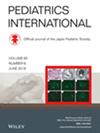新生儿低氧呼吸衰竭的氧饱和度指数
IF 1
4区 医学
Q3 PEDIATRICS
引用次数: 0
摘要
背景本研究旨在评估氧饱和度指数(OSI)和氧饱和度与吸入氧分数(FIO2)之比(S/F 比值)与经皮氧饱和度(OSISpO2 和 Sp/F 比值)的有效性,并评估这些值与氧指数(OI)之间的相关性。方法我们回顾了 2013 年至 2020 年期间需要进行有创机械通气的 77 例新生儿(胎龄 31.7 ± 6.1 周;出生体重 1768 ± 983 克)的数据,共计 1233 份动脉血气样本。我们计算了OI、OSISpO2、OSI与动脉血氧饱和度(SaO2)(OSISaO2)、Sp/F比值以及SaO2与FIO2的比值(Sa/F比值)。结果回归和Bland-Altman分析表明,OSISpO2或Sp/F比值与OSISaO2或Sa/F比值之间具有良好的一致性。虽然 OSISpO2 和 OI 之间存在明显的正相关,但在 SpO2 > 98% 的情况下,OSISpO2 被高估,拟合回归线的斜率高于 SpO2 98% 以下的斜率。此外,仅使用 SpO2 ≤ 98% 的样本进行接收器工作特征曲线分析表明,OSISpO2 和 Sp/F 比值预测 OI 的最佳临界点为:OI 5、3.0 和 3.0:结论 OSISpO2 和 Sp/F 比值的临界值可用于持续监测新生儿的氧合变化,具有更广泛的临床应用潜力。本文章由计算机程序翻译,如有差异,请以英文原文为准。
Oxygenation saturation index in neonatal hypoxemic respiratory failure
BackgroundThis study aimed to assess the validity of the oxygenation saturation index (OSI) and the ratio of oxygen saturation to the fraction of inspired oxygen (FI O2 ) (S/F ratio) with percutaneous oxygen saturation (OSISpO2 and the Sp /F ratio) and to evaluate the correlation between these values and the oxygen index (OI). It also determined their cut‐off values for predicting OI in accordance with neonatal hypoxic respiratory failure severity.MethodsWe reviewed the data of 77 neonates (gestational age 31.7 ± 6.1 weeks; birthweight, 1768 ± 983 g) requiring invasive mechanical ventilation between 2013 and 2020, 1233 arterial blood gas samples in total. We calculated the OI, OSISpO2 , OSI with arterial oxygen saturation (SaO2 ) (OSISaO2 ), Sp /F ratio, and the ratio of SaO2 to FI O2 (Sa /F ratio).ResultsThe regression and Bland–Altman analysis showed good agreement between OSISpO2 or the Sp /F ratio and OSISaO2 or the Sa /F ratio. Although a significant positive correlation was found between OSISpO2 and OI, OSISpO2 was overestimated in SpO2 > 98% with a higher slope of the fitted regression line than that below 98% of SpO2 . Furthermore, receiver‐operating characteristic curve analysis using only SpO2 ≤ 98% samples showed that the optimal cut‐off points of OSISpO2 and the Sp /F ratio for predicting OI were: OI 5, 3.0 and 332; OI 10, 5.3 and 231; OI 15, 7.7 and 108; OI 20, 11.0 and 149; and OI 25, 17.1 and 103, respectively.ConclusionThe cut‐off OSISpO2 and Sp /F ratio values could allow continuous monitoring for oxygenation changes in neonates with the potential for wider clinical applications.
求助全文
通过发布文献求助,成功后即可免费获取论文全文。
去求助
来源期刊

Pediatrics International
医学-小儿科
CiteScore
2.00
自引率
7.10%
发文量
519
审稿时长
12 months
期刊介绍:
Publishing articles of scientific excellence in pediatrics and child health delivery, Pediatrics International aims to encourage those involved in the research, practice and delivery of child health to share their experiences, ideas and achievements. Formerly Acta Paediatrica Japonica, the change in name in 1999 to Pediatrics International, reflects the Journal''s international status both in readership and contributions (approximately 45% of articles published are from non-Japanese authors). The Editors continue their strong commitment to the sharing of scientific information for the benefit of children everywhere.
Pediatrics International opens the door to all authors throughout the world. Manuscripts are judged by two experts solely upon the basis of their contribution of original data, original ideas and their presentation.
 求助内容:
求助内容: 应助结果提醒方式:
应助结果提醒方式:


